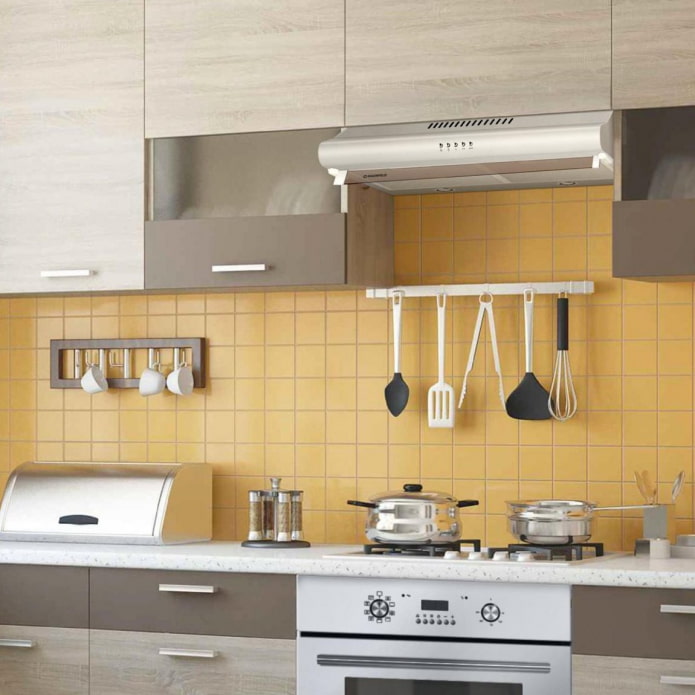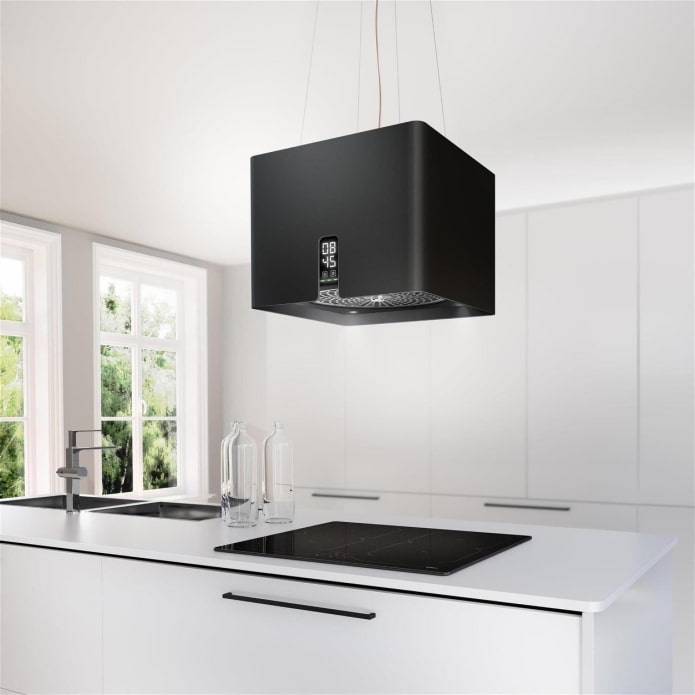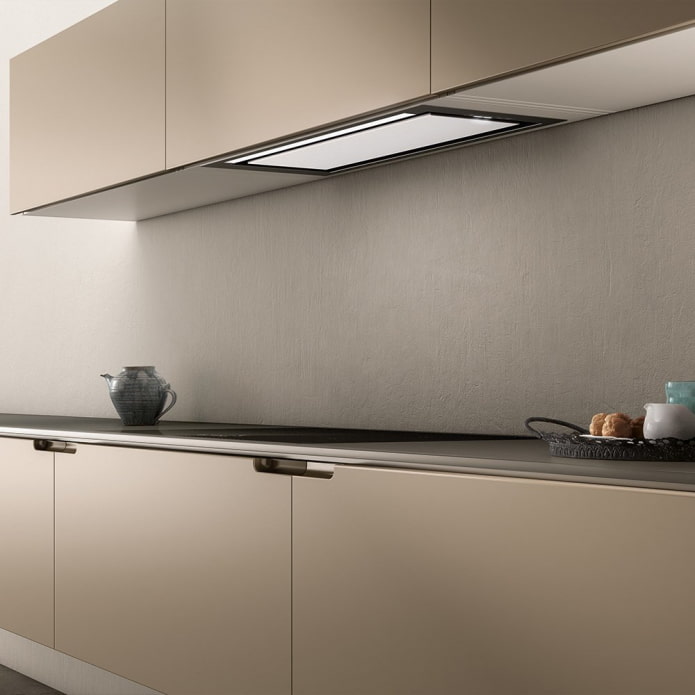A little theory
Before we start discussing the advantages and disadvantages of these household appliances, let’s briefly examine their classification.
According to the operating principle, hoods are divided into:
- recirculation – they draw in polluted air, clean it from soot, grease and grime using built-in filters and return it back to the room. They have medium or low power, require regular replacement of filter blocks, are noisy, do not cope well with unpleasant odors, but take up little space, are inexpensive and easy to install;
- flow-through – quickly remove dirty air outside through the ventilation system of the house along with unwanted odors, have impressive dimensions, require the involvement of specialists for proper installation, are expensive, but cope with their tasks perfectly and almost do not disturb the owners with extraneous sounds.
By design and installation method, they are:
- suspended – attached to the bottom of any cabinet;
- built-in – act as part of the furniture set and visually do not give themselves away;
- dome – rise above the stove and go into the ceiling or wall;
- island – installed in the center of the kitchen and cover a large area.
Yes hoods that combine flow-through and recirculation principles of operation and allow you to select the desired mode according to circumstances.




Arguments “FOR”
- “Quickly purifies the air.” In small apartments, especially studios, it is important to prevent the spread of intense olfactory irritants, otherwise they will gradually eat into the furniture and wallpaper, forming a characteristic atmosphere.
- “Saves from combustion products of household gas.” Owners of gas stoves should get a flow-through hood and use it correctly — turn it on after cooking, and not simultaneously with the burners.
- “Helps control humidity.” In addition to contaminants, both types of devices absorb water molecules, which are always in excess in the kitchen air.
- “Supplements and enhances ventilation.” In old apartment buildings, ventilation shafts are often clogged or the draft is impaired, which means that assistance will not be superfluous.
- “Simplifies cleaning.” Dirt and soot that does not go outside and does not settle in the filters turns into a hard-to-remove greasy film on surrounding surfaces.
- “Allows you to install a cabinet above the stove.” Furniture cannot be mounted directly above the burners, but a suspended or built-in hood removes this restriction.
- “Illuminates the work area.” We are talking about high-tech devices equipped with spot or strip lighting.
- “Acts as a designer accent.” There are dome and island models that look bright and stylish, adding chic and respectability to the kitchen interior.
- “Necessary for those in poor health.” Everyone needs clean air, especially people with allergies and chronic respiratory diseases. In addition, you won’t have to open the window in the middle of winter, risking catching a cold or ruining your houseplants.
- “In line with the trends of the times.” Some people buy a powerful, beautiful hood and use it regularly simply because it is prestigious and reasonable.
Arguments “AGAINST”
- “We’ve been doing without it our whole lives and nothing has happened.” Older people sincerely do not understand why they need to install additional air purification devices when it is enough to turn on a wall hood or arrange cross-ventilation through a window and door.
- “No extra money.” Any equipment requires costs for purchase, installation and maintenance, and if the budget is sharply limited, they usually save on secondary things, which include a hood.
- “There is so little space.” Of course, a bulky island or dome model will not fit into the interior of a Khrushchev-era kitchen, but it is not difficult to choose a suspended or built-in option.
- “It works too loudly.” Yes, outdated devices with a weak motor are far from the standards of acoustic comfort, but among the new products you can find an inexpensive and quiet hood.
- “Spoils the interior.” Equipment purchased for a ready-made kitchen can really stand out from the overall design concept. To avoid this, you need to plan your purchase in advance, at the stage of repair and arrangement.
- “Filters are a breeding ground for infection.” This will happen if you do not replace them in a timely manner and do not clean the inside of the device.
- “I have an electric/induction stove.” Under these conditions, the need for a kitchen hood is lower than when using gas, but cleaning the air from unnecessary moisture, odors and food particles will not hurt.
- “Household ventilation copes with ventilation.” A reasonable argument, but not everyone is so lucky.
- “I almost never cook at home.” Many busy people prefer to order food delivery, buy reheatable semi-finished products or eat out.
- “It’s a tribute to fashion.” Some people think that manufacturers of household appliances exaggerate the benefits of hoods in order to promote their products on the market and profit from suggestible buyers.
Conclusion
Those who often cook a lot on a gas stove and do not have high-quality household ventilation are better off installing a hood, choosing a model to suit their taste and budget.
Now reading:
- Living room area of 15 sq. m: photos and inspiration for interior design.
- Yellow wallpaper: more than 70 photos and ideas for the kitchen, bedroom, living room and hallway.
- Modern interior decoration ideas with wood: 77 photos for inspiration.
- Why Carpets Were Hung on Walls in the USSR: 5 Fascinating Reasons.
- White Bedroom: 55 Images, Design Ideas, and Decorating Options